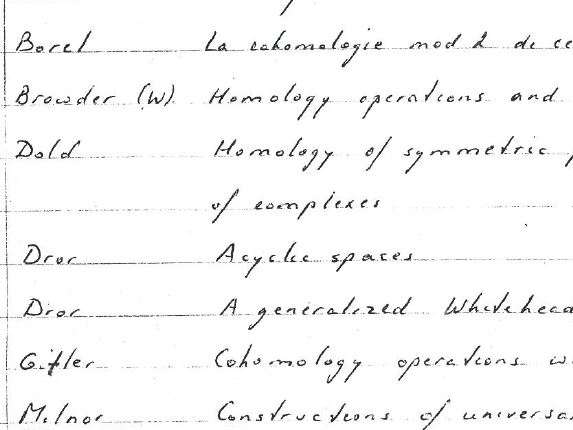In this section, Professor Haynes Miller discusses the reading list for the course and explains how it creates a narrative arc for understanding algebraic topology.
Narrative Arc
The exact set and sequence of papers read in the Kan seminar varies from one year to the next. The sequence in this particular year seemed to work out very well. The narrative arc of the course begins with Serre’s work from the early 1950’s: Fibrations, spectral sequences, and the cohomology of Eilenberg-Maclane spaces. As a prologue, we read about the construction and basic properties of Steenrod operations. These lead to a construction of the Stiefel-Whitney classes (from Milnor and Stasheff). We get started with simplicial sets using Milnor’s paper on geometric realization. This is followed by Thom’s work on the Steenrod problem and transversality. The oriented bordism ring and the Hirzebruch signature theorem is next (from Milnor and Stasheff). We are then in a position to understand Milnor’s paper on exotic 7-spheres.
Then K-theory comes along (from Atiyah’s book). (Sometimes we do a proof of Bott periodicity, but this is often part of a course in global analysis so I don’t mind omitting it.) We can then do Adams’s and Atiyah’s proof of Hopf invariant one, and (if there’s an ambitious student) Adams’s resolution of the vector field problem.

A portion of the original reading list (PDF), in Dan Kan’s handwriting. (Image courtesy of Michael Kan.)
Quillen’s work on equivariant cohomology is up next. Wall’s finiteness obstruction paper is very difficult for students, and may be inadvisable.
Stable homotopy theory follows, first Boardman’s construction of CW spectra following Adams, then May’s treatment of operads and the geometry of iterated loop spaces. Enough expertise with classifying spaces is in place for Quillen’s higher algebraic K-theory paper to make sense now. Nishida’s paper on nilpotence is always very hard and quite mysterious, somehow too far ahead of its time.
Atiyah and Hirzebruch’s paper on topological obstructions to the integral Hodge conjecture was a student suggestion. I think it worked well: An argument very much like Thom’s, but integrating K-theory and the topological Riemann-Roch theorem.
Now comes Quillen’s theory of model categories, followed immediately by Bousfield’s use of this formalism in the construction of localization functors and Sullivan’s rational homotopy theory (following Griffiths and Morgan).
After a while, the students will often start to propose their own papers. If the paper they propose seems reasonable, and connects well with the sequence of the course, then I welcome its inclusion. That’s exactly what I want to have happen.
Conversations about the Readings
I invite students to have individual conversations with me about the papers they are reading. Sometimes students feel frustrated with the papers because they have a difficult time understanding the writing. I listen patiently. I usually cannot help them very much with that aspect of the work, but the conversation gives me an opportunity to talk with them about the mathematics included in the papers. Students are ready to hear my thoughts about the mathematics in a way that they wouldn’t be if they weren’t struggling with reading the papers. Their struggles prime them for engagement and learning. I advertise these conversations as being 30-minute meetings, but in reality, we talk as long as students need to in order to make progress with their work.








